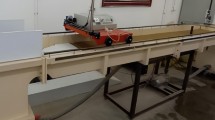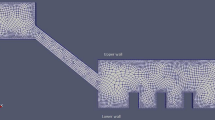Abstract
A smoothed particle hydrodynamics (SPH) numerical modeling method implemented for the forward simulation of propagation and deposition of flow-type landslides was combined with different empirical geomorphological index approaches for the assessment of the formation of landslide dams and their possible evolution for a local case study in southwestern China. The SPH model was calibrated with a previously occurred landslide that formed a stable dam impounding the main river, and it enabled the simulation of final landslide volumes, and the spatial distribution of the resulting landslide deposits. At four different sites on the endangered slope, landslides of three different volumes were simulated, respectively. All landslides deposited in the main river, bearing the potential for either stable impoundment of the river and upstream flooding scenarios, or sudden breach of incompletely formed or unstable landslide dams and possible outburst floods downstream. With the empirical indices, none of the cases could be identified as stable formed landslide dam when considering thresholds reported in the literature, showing up the limitations of these indices for particular case studies of small or intermediate landslide volumes and the necessity to adapt thresholds accordingly for particular regions or sites. Using the occurred benchmark landslide as a reference, two cases could be identified where a complete blockage occurs that is more stable than the reference case. The other cases where a complete blockage was simulated can be considered as potential dam-breach scenarios.












Similar content being viewed by others
Abbreviations
- BI:
-
Blockage index
- DBI:
-
Dimensionless blockage index
- DEM:
-
Digital elevation model
- DTM:
-
Digital terrain model
- IR:
-
Relief index
- MOI:
-
Morphological obstruction index
- HDSI:
-
Hydrodynamic dam stability index
- SPH:
-
Smoothed particle hydrodynamics
References
Blanc T (2008) Numerical simulation of debris flows with the 2D SPH depth-integrated model. Master’s thesis, Institute for Mountain Risk Engineering, University of Natural Resources and Applied Life Sciences, Vienna, Austria
Blanc T, Pastor M, Drempetic MSV, Haddad B (2011) Depth integrated modelling of fast landslides propagation. Eur J Environ Civil Eng 15:51–72
Braun A, Wang X, Petrosino S, Cuomo S (2017) SPH propagation back-analysis of Baishuihe landslide in south-western China. Geoenviron Disasters 4(1):2
Cascini L, Cuomo S, Pastor M, Sorbino G, Piciullo L (2014) SPH run-out modelling of channelised landslides of the flow type. Geomorphology 214:502–513
Cascini L, Cuomo S, Pastor M, Rendina I (2016) SPH-FDM propagation and pore water pressure modelling for debris flows in flume tests. Eng Geol 213:74–83
Corominas J, Van Westen C, Frattini P, Cascini L, Malet JP, Fotopoulou S, Catani F, Van Den Eeckhaut M, Mavrouli O, Agliardi F, Pitilakis K, Winter MG, Pastor M, Ferlisi S, Tofani V, Hervás J, Smith JT (2014) Recommendations for the quantitative analysis of landslide risk. Bull Eng Geol Environ 73(2):209–263
Costa JE, Schuster RL (1988) The formation and failure of natural dams. Geol Soc Am Bull 100(7):1054–1068
Cuomo S (2014) New advances and challenges for numerical modeling of landslides of the flow type. Procedia Earth Planet Sci 9:91–100
Cuomo S, Pastor M, Capobianco V, Cascini L (2016) Modelling the space–time evolution of bed entrainment for flow-like landslides. Eng Geol 212:10–20
Cuomo S, Pastor M, Cascini L, Castorino GC (2014) Interplay of rheology and entrainment in debris avalanches: a numerical study. Can Geotech J 51(11):1318–1330
Cuomo S, Pastor M, Vitale S, Cascini L (2013) Improvement of irregular DTM for SPH modelling of flow-like landslides. Proc. of XII international conference on computational plasticity. Fundamentals and applications (COMPLAS XII), Oñate E, Owen DRJ, Peric D, Suárez B (Eds). 3-5 September 2013, Barcelona, Spain. ISBN: 978-84-941531-5-0, pp. 512-521
Deng B, Liu SG, Enkelmann E, Li ZW, Ehlers TA, Jansa L (2014) Late Miocene accelerated exhumation of the Daliang Mountains, southeastern margin of the Tibetan Plateau. Int J Earth Sci 104(4):1–21
Ermini L, Casagli N (2003) Prediction of the behavior of landslide dams using a geomorphical dimensionless index. Earth Surf Process Landf 28:31–47
Fan X, Rossiter DG, Westen CJ, Xu Q, Görüm T (2014) Empirical prediction of coseismic landslide dam formation. Earth Surf Process Landf 39(14):1913–1926
Fan X, van Westen CJ, Xu Q, Gorum T, Dai F (2012) Analysis of landslide dams induced by the 2008 Wenchuan earthquake. J Asian Earth Sci 57:25–37
Fan X, Xu Q, van Westen CJ, Huang R, Tang R (2017) Characteristics and classification of landslide dams associated with the 2008 Wenchuan earthquake. Geoenviron Disasters 4(1):12
Fell R, Corominas J, Bonnard C, Cascini L, Leroi E, Savage WZ (2008) Guidelines for landslide susceptibility, hazard and risk zoning for land-use planning. Eng Geol 102(3):99–111
Gingold RA, Monaghan JJ (1977) Smoothed particle hydrodynamics: theory and application to non-spherical stars. Mon Not R Astron Soc 181(3):375–389
Huang Y, Zhang W, Xu Q, Xie P, Hao L (2012) Run-out analysis of flow-like landslides triggered by the M s 8.0 2008 Wenchuan earthquake using smoothed particle hydrodynamics. Landslides 9(2):275–283
Hungr O, Leroueil S, Picarelli L (2014) The Varnes classification of landslide types, an update. Landslides 11(2):167–194
Hutchinson JN (1986) A sliding-consolidation model for flow slides. Can Geotech J 23(2):115–126
JAXA (2016) ALOS global digital surface model “ALOS world 3D–30m” (AW3D30 DSM ver. 1.0), data available from the Japanese Aerospace Exploration Agency (JAXA) web interface, http://www.Eorc.Jaxa.Jp/ALOS/en/aw3d30/data/index.Htm, accessed on 14 November, 2016
Korup O (2004) Geomorphometric characteristics of New Zealand landslide dams. Eng Geol 73(1):13–35
Lucy LB (1977) A numerical approach to the testing of the fission hypothesis. Astron J 82:1013–1024
McDougall S, Hungr O (2004) A model for the analysis of rapid landslide motion across three-dimensional terrain. Can Geotech J 41(6):1084–1097
Okeke ACU, Wang F (2016) Critical hydraulic gradients for seepage-induced failure of landslide dams. Geoenviron Disasters 3(1):9
Pastor M, Crosta GB (2012) Landslide runout: review of analytical/empirical models for subaerial slides, submarine slides and snow avalanche. Numerical modelling. Software tools, material models, validation and benchmarking for selected case studies. Deliverable D1.7 for SafeLand project http://www.Safeland-fp7.Eu/results/documents/D1.7_revised.Pdf., 2012
Pastor M, Quecedo M, Fernández-Moredo JA, Herreros MI, González E, Mira P (2002) Modelling tailings dams and mine waste dumps failures. Géotechnique 52:579–591
Pastor M, Haddad B, Sorbino G, Cuomo S, Drempetic V (2009) A depth-integrated, coupled SPH model for flow-like landslides and related phenomena. Int J Numer Anal Methods Geomech 33:143–184
Pastor M, Blanc T, Haddad B, Petrone S, Morles MS, Drempetic V, Issler D, Crosta GB, Cascini L, Sorbino G, Cuomo S (2014) Application of a SPH depth-integrated model to landslide run-out analysis. Landslides 11(5):793–812
Peng M, Zhang LM (2012) Breaching parameters of landslide dams. Landslides 9(1):13–31
Pirulli M, Pastor M (2012) Numerical study on the entrainment of bed material into rapid landslides. Géotechnique 62(11):959–972
Swanson FJ, Oyagi N, Tominaga M (1986) Landslide dams in Japan. In: Schuster RL (ed) Landslide dams: processes risk and mitigation, Geotechnical special publication Vol, vol 3. American Society of Civil Engineering, New York, pp 131–145
Tacconi Stefanelli C, Catani F, Casagli N (2015) Geomorphological investigations on landslide dams. Geoenvironmental Disasters 2(1):1–15
Tacconi Stefanelli C, Segoni S, Casagli N, Catani F (2016) Geomorphic indexing of landslide dams evolution. Eng Geol 208:1–10
USGS (2015) SRTM 1 arc-second global elevation data, data available from the U.S. Geological Survey (USGS) via the EarthExplorer web interface, https://earthexplorer.usgs.gov/, accessed on 7 February, 2017
Acknowledgements
The authors would like to thank the support of the National Natural Science Foundation of China (Grant No. 41402285 and Grant No. 41650110487) and the Chinese Academy of Sciences President’s International Fellowship Initiative (Grant No. 2016PZ032). Prof. Manuel Pastor (Universidad Politecnica de Madrid, Spain) and co-workers are much acknowledged for having provided the “GeoFlow_SPH” code used for the numerical simulations.
Author information
Authors and Affiliations
Corresponding authors
Rights and permissions
About this article
Cite this article
Braun, A., Cuomo, S., Petrosino, S. et al. Numerical SPH analysis of debris flow run-out and related river damming scenarios for a local case study in SW China. Landslides 15, 535–550 (2018). https://doi.org/10.1007/s10346-017-0885-9
Received:
Accepted:
Published:
Issue Date:
DOI: https://doi.org/10.1007/s10346-017-0885-9




